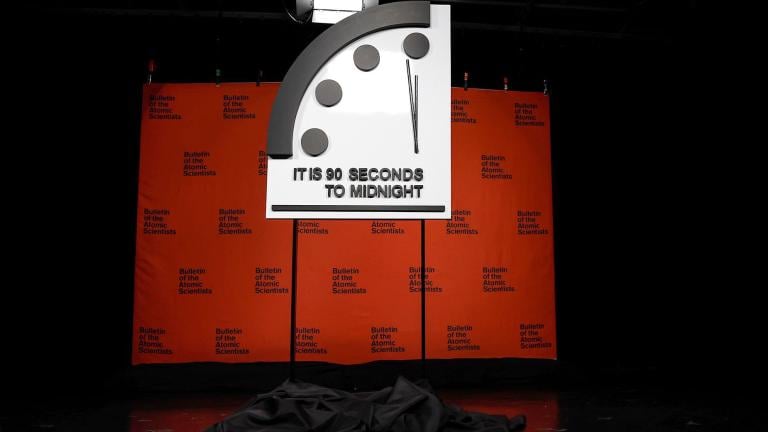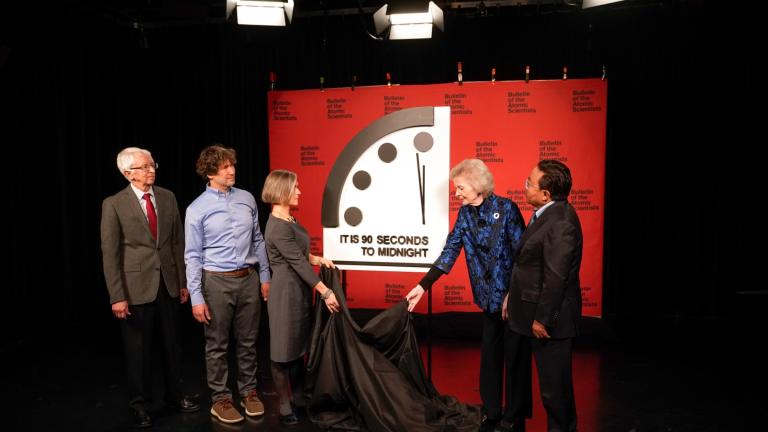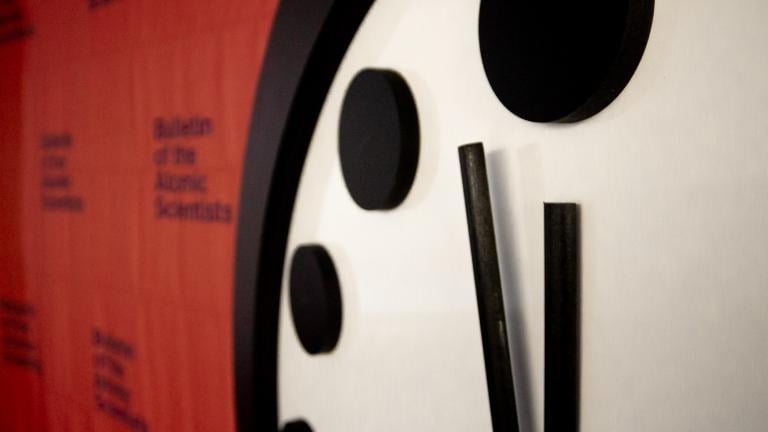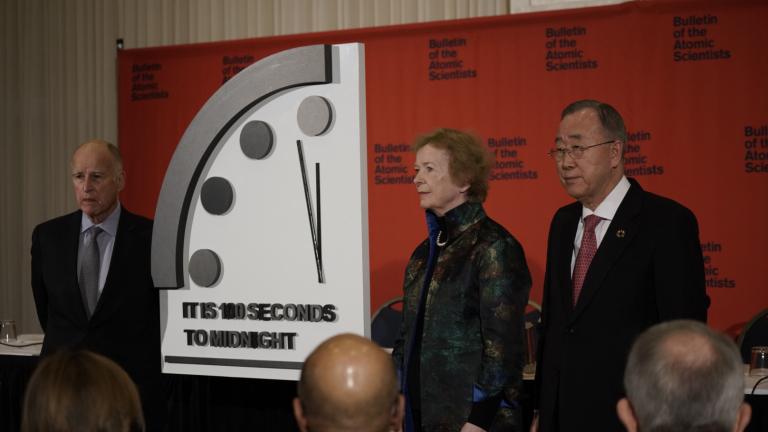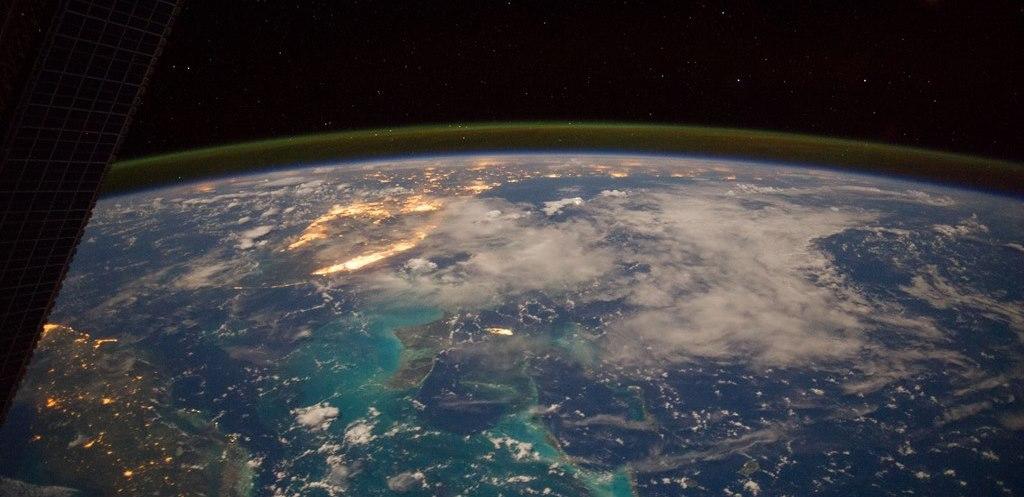 The Bulletin of the Atomic Scientists says "global danger looms" and that "wise leaders should act immediately." (NASA)
The Bulletin of the Atomic Scientists says "global danger looms" and that "wise leaders should act immediately." (NASA)
It’s 2016 and we’re still three metaphorical minutes away from global doom.
In a public letter addressed to the “leaders and citizens of the world,” the academic journal Bulletin of the Atomic Scientists recently announced the hands of their Doomsday Clock would remain at the perilous position of three minutes to midnight.
The symbolic clock is a signifier of how close the world is to global catastrophe. In annually assessing global threats, the publication focuses on four major areas: nuclear warfare, climate change, nuclear waste disasters and the danger of “emerging technologies” like destructive artificial intelligence.
The Bulletin has used the Doomsday Clock to raise public awareness and promote public policy since 1947, two years after the journal’s inception. The decision to move the clock’s hands is made by the Bulletin’s Science and Security Board in consultation with its Board of Sponsors, which includes 16 Nobel Laureates.
The Doomsday Clock's time was set to its current position last year. Lack of significant progress in reducing global warming and nuclear weapon proliferation were major factors in the clock remaining the same this year, according to the letter. While last year’s Paris climate accord and Iran nuclear deal indicate steps towards positive change, the Bulletin states in its open letter that “they constitute only small bright spots in a darker world situation full of potential for catastrophe.”
With regard to the darker world situation, the journal points to North Korea’s recent nuclear testing, nuclear modernization programs by the U.S. and other states as well as the rapid pace of climate change.
[Archives: 2015 Was the Hottest Recorded Year on Earth] Rachel Bronson (Bulletin of the Atomic Scientists)
Rachel Bronson (Bulletin of the Atomic Scientists)
This is the second closest the clock has ever been to midnight. In 1953, the minute hand was moved two minutes to midnight after both the United States and Soviet Union tested hydrogen bombs.
We spoke with the Bulletin’s executive director Rachel Bronson about their decision to leave the Doomsday Clock at three minutes to midnight.
Chicago Tonight: The Paris climate accord and Iran nuclear agreement both seem to be significant events with the potential to move the clock further from midnight since they touch on two major areas of concern for the Bulletin. Why weren’t those events enough to do it this year?
Rachel Bronson: There were two reasons. The first is they were balanced against a bunch of very troubling events that happened over the course of the year. The Board focuses on the hundreds of millions of dollars that are going into nuclear modernization programs across all nuclear states, particularly the United States and Russia.
That money seems beyond what is needed to simply keep the weapons safe. It seems to be a roundabout way to build and invest in nuclear weapons, rather than to disarm. So there’s real concern that we’re continuing to maintain and bolster our nuclear fleets. We’re very concerned about the continued deterioration between U.S. and Russian relations. We had former U.S. Secretary of Defense Bill Perry on our panel yesterday talking about the fact that when he looks outside, it feels to him that the present moment is no less dangerous than the times of the Cold War and the Board wanted to convey that. And then we have the nuclear tests from North Korea and some other things. All of that was very worrisome.
But the second part, about both Paris and Iran that I think are really important: On Iran, there was considerable enthusiasm for the Iran deal but we just passed implementation day a week ago, so there is a bit of a feeling that it’s too soon to tell. It looks like it has the potential to really reduce Iran’s ability to be a nuclear state, but a lot of that will be in the implementation.
And on the Paris negotiations, there was similar logic. The Board did think it was a tremendous step forward, but these are pledges and they’re not verifiable at this moment. Even if every country achieves the pledges that they set out, we would still go beyond 2 degrees Celsius, so on both of them, there is a too-soon-to-tell feeling. In a year or two when maybe public attention has shifted off of Paris or Iran, we really are going to have to make a statement about whether the implementation is going well and think about what that means for the clock.
Three minutes to midnight is not a good sign, but there are these two bright spots and I think they’re really important bright spots.
CT: Do you think without those “bright spots” the clock would’ve moved closer to midnight this year?
RB: I don’t know. There’s always that potential. We didn’t have that situation, so we weighed what we saw and what we knew. We’re always trying to think with an eye to the past of where we’ve been and also what’s coming on the horizon. It’s about thinking how we balance these two major events.
What I think is so important about both Paris and the Iran deal, it was public pressure as well as political leadership that really created these tremendous bright spots that have the potential over time to move the clock back. So when people ask, ‘What can we do?’ this year is a really good example of where political leadership, definitely inspired by public pressure on the climate side, led to this bright spot.
![]()
“There is a tendency, especially with nuclear security, to think that all these issues can be put to bed as Cold War problems that aren’t relevant anymore, but these issues are back in the headlines, they’re front page news.”
–Rachel Bronson
CT: North Korea plays a more prominent role in the Bulletin’s Doomsday Clock this year than last due to their recent nuclear weapon testing. How dangerous is the situation with North Korea now as opposed to last year?
RB: I think the situation with North Korea is very dangerous and the Board really did want to call that out. North Korea tested their nuclear weapon after the Board met, so they had another round of discussions about North Korea and felt that they’re comfortable leaving the clock where it is but to highlight that as a very current threat.
There is a tendency, especially with nuclear security, to think that all these issues can be put to bed as Cold War problems that aren’t relevant anymore, but what we’re seeing is these issues are back in the headlines, they’re front page news. This morning the news reported Japan was anticipating another test from North Korea. For us, it’s important to highlight that some of the actors are changing but that the danger is still there. Perry said yesterday that our politics aren’t keeping up with the dangers we’re facing.
We saw that a little bit in the debate with the difficulty in talking about what a nuclear triad is. In some ways, we haven’t talked about nuclear triads in our public discussion for a few decades, but that doesn’t mean that it’s not very important to understand. We’re investing hundreds of millions of dollars in it. So, money is going into modernizing the triad and not going to other things, which voters should care about and think about. But also, that in a moment when North Korea is nuclear testing and we have the Iran deal, it seems important to expect that our political leaders get up to speed really fast on these issues if they’re not already.
CT: That’s right. One would expect someone running for president to know what a nuclear triad is.
RB: [Laughs] It’s one thing when it’s in the debate and it seems like a “gotcha question” and maybe divorced from the key issues of our day – until you remember that the key issues of our day are the Iran nuclear deal and North Korea testing nuclear weapons. Not only are they important in general, but over the last six months these issues have dominated the headlines.
[Archives: Doomsday Clock Moves 3 Minutes to Midnight]
CT: Speaking of headlines, among the concerns the Bulletin has, which do you think the public knows the least about?
RB: Existential threats are manifesting themselves differently in 2015 and 2016 than they were in 1950. In regards to emerging technologies, we always look across the horizon and we look at genetic engineering, bio-engineering, artificial intelligence and cyber threats. Do these issues rise to the level of nuclear threats and climate change? They rise to the level in that we try to bring attention to them. But it hasn’t been a major focus right now because it’s something important that bears watching. It is marked as an area that we want to keep watching.
Also, here in the United States, we can’t come to a decision on how to store nuclear waste. There are a lot of environmental fights over it. The result is that because we can’t move forward with some of the better storage options, the waste is being stored not as safely as it could be. So that is something that we want to bring attention to.
We knew that climate change and nuclear security would get more attention, but we do want to put these threats out there.
CT: Is the U.S. hypocritical when it comes to nuclear weapons? Your publication’s public letter points out that we’re planning to spend $350 million over the next decade to modernize our nuclear forces.
RB: It’s harder to lead when we don’t seem to be practicing what we preach. I think the Board and many others can agree that we should be modernizing our force. We don’t want leaky, rickety storage facilities and weapons that are unstable. So, to a degree, modernization is necessary.
But we think the kinds of investments that are being made are actually beyond what’s needed and it seems to be a way to continue to build and enhance the forces. That’s true for us and the rest of the nuclear states. The Board doesn’t feel particularly bullish on any state. But it is harder to lead.
What the Nuclear Non-Proliferation Treaty states is that every country has the right to peaceful civilian nuclear power and countries who don’t have nuclear weapons won’t try to get them and countries that have them will seek to get rid of them. So it’s harder to point the fingers at those who are trying to get them and tell them they have to follow that treaty when it doesn’t seem like we’re moving in a direction of disarmament. I agree with you. It’s harder to lead on nuclear disarmament when we’re investing as much as we are.
Interview was condensed and edited.
Watch the Bulletin's Science and Security Board Announce the 2016 Doomsday Clock's Placement:

